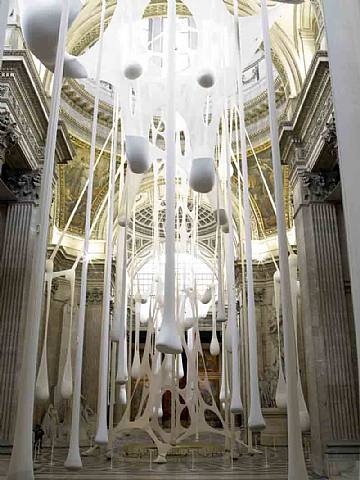Ernesto Neto
Ernesto Neto is a Brazilian Conceptual artist who lives and works in Rio de Janeiro, Brazil. His main focus is installations and sculpture. He began pursuing art in the 1960’s when he enrolled in art school. He realized sculpture was what he wanted to do after taking a clay workshop. His first solo exhibition was at the Petite Galerie in 1988 in Rio. Along with having his studio there, he also runs a gallery called A Gentil Carioca featuring new Brazilian artists. His work is now featured in many esteemed galleries including places such as New York, Paris, London, Tokyo, Los Angeles, and more.
Neto’s work is largely about interaction. It is inspired by things like nature and the human body, specifically skin and the body’s relationship with water. In an interview Neto says, “There is always an edge between one thing and another – a membrane. My work is very much about this limit between one side and the other”. Some subjects that influence his work as well is his known interest in anthropology, cultural history, and physics. Neto’s works consist of fabrics, transparent, stretchy material, styrofoam pellets and spices to create his installations. The viewer is meant to feel, touch, and sometimes smell each piece he makes. He provides many ways to interact with his pieces, extending so far as to one piece that you can actually swim in.
One work called Mother body emotional densities, for alive temple time baby son displays his combination of fabric and spices. The fabric is polyester Lyrca and gives the impression of skin. The skin bags at\re filled with spices such as turmeric, clove, cumin, ginger, pepper, and annatto. This work was featured in the Museum of Contemporary Art in San Diego.
Another work called Léviathan Thot featured in Europe at ‘le Panthéon’, Paris is a good example of the use of line and shape as well as unity and space. The materials used is lycra tulle, polyamide fabric, and styrofoam balls. The way the fabric is stretch and thin at the top and enlarged at the bottom by the placement of styrofoam. It is said to be a representation of the story in the Old Testament about the sea serpent, Leviathan in the book of Job.
- Unity- Consistency with the droplets and how it is all tied together in the center.
- Line- The lines in this piece help it create a more representative feel. For example, the structures in this piece are often referred to as resembling raindrops, tears, webs. The lines again, spawn from the center. Your eye naturally moves from that center and all fabric from the top is thin and your eye is drawn to the bottom which again leads to the center.
- Space- The space in this helps create depth and interest. For example, if there were no holes in the center piece, all there would be is a white sheet and the eye wouldn’t be drawn as much.
- Shape- The shapes in this piece are important because if, for example, the styrofoam wasn’t round of the fabric wasn’t thin then it would give it a completely different feel and may not tell the same story.
